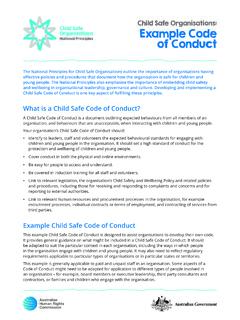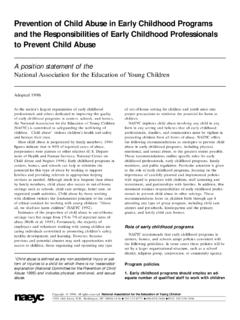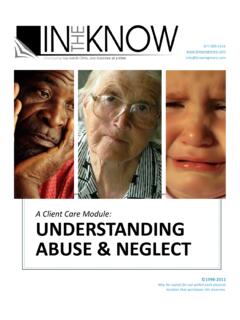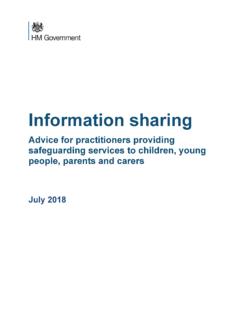Transcription of National Principles for Child Safe Organisations
1 An initiative of the Council of Australian GovernmentsNational Principlesfor Child SafeOrganisationsThe Australian Human Rights Commission encourages the dissemination and exchange of information presented in this publication and endorses the use of the Australian Governments Open Access and Licensing Framework (AusGOAL).All material presented in this publication is licensed under the Creative Commons Attribution International Licence, with the exception of: photographs and images; the Commission s logo, any branding or trademarks; content or material provided by third parties; and where otherwise view a copy of this licence, visit essence, you are free to copy, communicate and adapt the publication, as long as you attribute the Australian Human Rights Commission and abide by the other licence terms. Please give attribution to: Australian Human Rights Commission 2018. Acknowledgements:The Australian Human Rights Commission acknowledges the National Principles for Child safe Organisations project is funded by the Australian Government Department of Social Services and the National Principles have been developed under the oversight and guidance of the Community Services Ministers across all jurisdictions.
2 Further information:For further information about the copyright in this publication, please contact:Communications UnitAustralian Human Rights CommissionGPO Box 5218 SYDNEY NSW 2001 Telephone: (02) 9284 9600 Email: | National Principles for Child safe OrganisationsForewordThe Royal Commission into Institutional Responses to Child sexual abuse (Royal Commission) uncovered shocking abuse of children within institutions in Commission recommended taking action to make Organisations across the country safe for development of the National Principles for Child safe Organisations ( National Principles ) is a key National reform in response to these Principles have been endorsed by all Commonwealth, state and territory provide a nationally consistent approach to embedding Child safe cultures within Organisations that engage with children, and act as a vehicle to give effect to all Royal Commission recommendations related to Child safe standards.
3 I would like to thank all who contributed to the development of the National Principles and their accompanying guidance of the National Principles was led by Community Services Ministers across Australia under the Third Action Plan 2015-2018 of the National Framework for Protecting Australia s Children 2009-2020 and the National Children s Commissioner, Megan Mitchell, in consultation with a broad range of sectors engaging with children. Representatives from key advocacy groups and academia also contributed, as well as children and young people themselves. Adopting the National Principles is an important step to better protecting Australia s children. Scott MorrisonPrime Minister of AustraliaChair of the Council of Australian GovernmentsNational Principles for Child safe Organisations | 3 PreambleA wide range of Organisations work with children and young people throughout Australia. These may be small and community based, such as a sports club or playgroup where families and community members contribute voluntarily, through to more highly organised structures like schools, hospitals and churches.
4 They may also be businesses or Organisations employing staff and/or volunteers providing services to and working with children and young people. Some may work across state 2013, the Australian Government established a Royal Commission into Institutional Responses to Child sexual abuse (Royal Commission) in response to community concern about widespread reports of cases where Australian institutions failed to protect children from sexual abuse . The Commission s final recommendations emphasised that members of the public, children and young people, parents, carers, families and communities should feel confident that Organisations working with children provide safe environments in which children s rights, needs and interests are National Principles draw on the work of the Royal Commission, Australia s Children s Commissioners and Guardians and the 2005 National Framework for Creating safe Environments for provide a National approach to embedding a Child safe culture across all sectors of Australian society in which children are involved.
5 Underpinned by a Child -rights approach and based on the standards recommended by the Royal Commission, the National Principles are designed to build capacity and deliver Child safety and wellbeing in Organisations , families and communities and prevent future harm. In order to allow flexibility in implementation and in recognition of the variety of organisational types, sizes and capacities, the National Principles outline at a high level the 10 elements that are fundamental for making an organisation safe for children. The National Principles emphasise the importance of culturally safe environments and practices for Aboriginal and Torres Strait Islander children and young people. Aboriginal and Torres Strait Islander families and communities are more likely to access services that are culturally safe and experience better outcomes in such services. This includes improving the way Organisations engage with Aboriginal and Torres Strait Islander children and their families, recognising the impact of intergenerational trauma, and respecting cultural diversity.
6 The National Principles collectively show that a Child safe organisation is one that creates a culture, adopts strategies and takes action to promote Child wellbeing and prevent harm to children and young people. A Child safe organisation consciously and systematically: creates an environment where children s safety and wellbeing is the centre of thought, values and actions places emphasis on genuine engagement with, and valuing of children creates conditions that reduce the likelihood of harm to children and young people creates conditions that increase the likelihood of identifying any harm responds to any concerns, disclosures, allegations or suspicions. The adoption and application of National Child safe Principles in any institution or organisation across Australia, in which children are involved, is a significant milestone in promoting Child safety and | National Principles for Child safe OrganisationsCommittedleadership,governa nceand cultureFamilies andcommunitiesinvolved in safetysettingsRegularimprovementEquity upheld and diversity respectedSafe physicaland onlineenvironments Children and young people are safe , informed and actively participate in the organisation Child safetyand wellbeingpolicies and proceduresRobustrecruitment and screeningEffectivecomplaintsmanagementSa fe, happyand engaged childrenOngoingeducation andtrainingWheel of Child SafetyNational Principles for Child safe safety and wellbeing is embedded in organisational leadership,governance and and young people are informed about their rights.
7 Participate in decisions affecting them and are taken and communities are informed and involved inpromoting Child safety and is upheld and diverse needs respected in policy and working with children and young people are suitable andsupported to reflect Child safety and wellbeing values in to respond to complaints and concerns are Child and volunteers are equipped with the knowledge, skillsand awareness to keep children and young people safe throughongoing education and and online environments promote safety and wellbeingwhile minimising the opportunity for children and young people tobe of the National Child safe Principles is regularlyreviewed and and procedures document how the organisation is safe forchildren and young | National Principles for Child safe OrganisationsAs of 1 February 2019, all Parties have confirmed their commitment to the National Principles for Child SafeOrganisations as follows.
8 The Prime Minister of Australia on behalf of the Commonwealth of AustraliaThe Hon Scott Morrison MPThe Premier of New South Waleson behalf of the State ofNew South WalesThe Hon Gladys Berejiklian MPThe Premier of Victoria on behalfof the State of VictoriaThe Hon Daniel Andrews MPThe Premier of Queensland on behalfof the State of QueenslandThe Hon Annastacia Palaszczuk MPThe Premier of Western Australia on behalf of the State of Western AustraliaThe Hon Mark McGowan MLAThe Premier of South Australia onbehalf of the State of South AustraliaThe Hon Steven Marshall MPThe Acting Premier of Tasmania onbehalf of the State of TasmaniaThe Hon Jeremy Rockliff MPThe Acting Chief Minister of theAustralian Capital Territory on behalfof the Australian Capital TerritoryMs Yvette Berry MLAThe Chief Minister of theNorthern Territory on behalfof the Northern Territory The Hon Michael Gunner MLAN ational Principles for Child safe Organisations | 7 Australia ratified the United Nations Convention on the Rights of the Child (CRC) in 1990.
9 Under the Convention, children, like adults, possess human rights. They also have the right to special protection because of their vulnerability to exploitation and abuse . Under the Convention, a Child is defined as every human being below eighteen years of age. The following pages provide detailed guidance on each of the Principles to support the adoption of the National Principles across all Organisations engaging with children across Australia. For each principle, the guidance provides: the intent and key elements of the principlekey action areas, showing where Organisations should take action to create a culture of Child safetyindicators that the principle is upheld, providing practical examples of signs that the principle is effectively in placereferences to examples of relevant Articles of the CRC. This guidance is intended to support Organisations to consistently and effectively implement the National Principles .
10 It is provided as a best practice guide and allows flexibility in implementation and in recognition of the variety of organisational types, sizes and set of tools and resources to support implementation of the National Principles within Organisations can be accessed through the National Office for Child Safety webpage ( ). Guidance8 | National Principles for Child safe OrganisationsPrinciple1 Child safety and wellbeing is embedded in organisational leadership, governance and principle provides guidance on the role of organisational leadership and governance in promoting inclusive and welcoming environments for children and young people, a culture of accountability and the ways in which a Child safe culture is developed and of this principle shows that the organisation has a commitment to Child safety and wellbeing through all levels of the organisation . Governance arrangements are transparent and include a Child safety and wellbeing policy, practice guidance, a Code of Conduct and a risk management framework.








